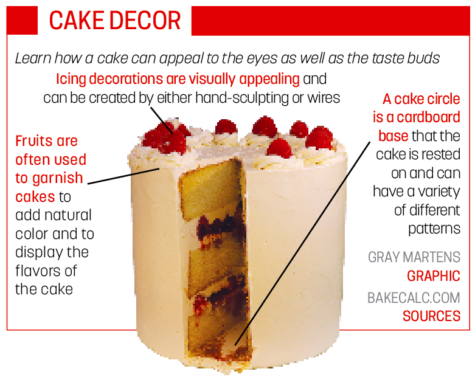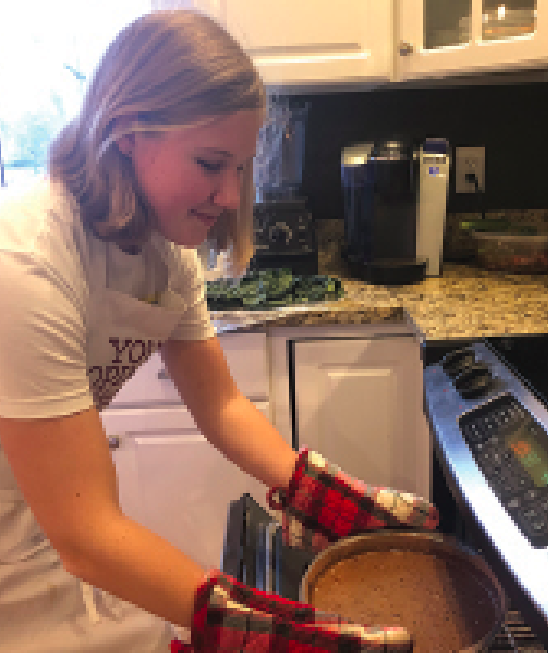When Tessa Hedrick, baking enthusiast and sophomore, walked into SRT, she brought a cake to share with friends. However, she wasn’t carrying a simply frosted cake, but rather a black forest cake, which was significantly more decorated, from the cherry on top to chocolate flakes on the sides.
Hedrick said looks are just as important as taste for items she makes, particularly depending on the situation.
“Usually when I’m making (a cake) for an event or something, like I’m making a cake for a birthday, I think looks are a little bit more important,” Hedrick said. “Whereas if I’m making something just for myself or my family to enjoy, I’m not as focused on what it looks like and more of what it tastes like.”
However, according to Lila Torp, who teaches baking and orientation to foods, looks can be an important factor in edible products as sight is the dominant sense for humans, though taste should generally hold the most importance.

“In general, I think we taste first with our eyes because we see it before we taste it,” Torp said. “I think that both of those (senses) are important. Ultimately, flavor wins.”
Hedrick agreed, saying that for her, taste holds a more significant role in the case of food.
“I think (there should be) more emphasis on taste. That’s what the important part of baking is. That’s the goal, right?” Hedrick said. “(The taste is) what you’re enjoying. It only looks pretty until you start eating it.”
Nonetheless, it’s hard to definitively say the looks of food aren’t as important as taste. Junior Natalie Walters, who currently works a part-time job as a teaching assistant at the Sprouts Cooking School, said the appearance and taste of foods are both important, and each aspect has a time and place when it is more crucial.
“When the parents come (to see their children at school), we like to show the parents what the kids have learned and I think the best way to show that is really through a nice presentation of whatever food they’ve created,” Walters said. “Then throughout the classes, it’s really about enhancing flavor and figuring out spices and the amount.”
In the end, Torp said that creating and consuming food may not only be an experience for one’s taste buds, but actually one involving nearly all five senses. She also said that she emphasizes senses other than taste in her baking and orientation to foods classes.
“We certainly focus on appearance in terms of evenness of coloring. We focus on texture—so not only what the texture looks like, but the mouth-feel,” Torp said. “We focus certainly on flavor. There are some things where we use smell (and)when you get to the point where you can almost smell the food, it’s almost done. You can’t separate all those (senses) in baking class.”































![What happened to theater etiquette? [opinion]](https://hilite.org/wp-content/uploads/2025/04/Entertainment-Perspective-Cover-1200x471.jpg)














































![Review: “The Immortal Soul Salvage Yard:” A criminally underrated poetry collection [MUSE]](https://hilite.org/wp-content/uploads/2025/03/71cju6TvqmL._AC_UF10001000_QL80_.jpg)
![Review: "Dog Man" is Unapologetically Chaotic [MUSE]](https://hilite.org/wp-content/uploads/2025/03/dogman-1200x700.jpg)
![Review: "Ne Zha 2": The WeChat family reunion I didn’t know I needed [MUSE]](https://hilite.org/wp-content/uploads/2025/03/unnamed-4.png)
![Review in Print: Maripaz Villar brings a delightfully unique style to the world of WEBTOON [MUSE]](https://hilite.org/wp-content/uploads/2023/12/maripazcover-1200x960.jpg)
![Review: “The Sword of Kaigen” is a masterpiece [MUSE]](https://hilite.org/wp-content/uploads/2023/11/Screenshot-2023-11-26-201051.png)
![Review: Gateron Oil Kings, great linear switches, okay price [MUSE]](https://hilite.org/wp-content/uploads/2023/11/Screenshot-2023-11-26-200553.png)
![Review: “A Haunting in Venice” is a significant improvement from other Agatha Christie adaptations [MUSE]](https://hilite.org/wp-content/uploads/2023/11/e7ee2938a6d422669771bce6d8088521.jpg)
![Review: A Thanksgiving story from elementary school, still just as interesting [MUSE]](https://hilite.org/wp-content/uploads/2023/11/Screenshot-2023-11-26-195514-987x1200.png)
![Review: "When I Fly Towards You", cute, uplifting youth drama [MUSE]](https://hilite.org/wp-content/uploads/2023/09/When-I-Fly-Towards-You-Chinese-drama.png)
![Postcards from Muse: Hawaii Travel Diary [MUSE]](https://hilite.org/wp-content/uploads/2023/09/My-project-1-1200x1200.jpg)
![Review: "Ladybug & Cat Noir: The Movie," departure from original show [MUSE]](https://hilite.org/wp-content/uploads/2023/09/Ladybug__Cat_Noir_-_The_Movie_poster.jpg)
![Review in Print: "Hidden Love" is the cute, uplifting drama everyone needs [MUSE]](https://hilite.org/wp-content/uploads/2023/09/hiddenlovecover-e1693597208225-1030x1200.png)
![Review in Print: "Heartstopper" is the heartwarming queer romance we all need [MUSE]](https://hilite.org/wp-content/uploads/2023/08/museheartstoppercover-1200x654.png)



